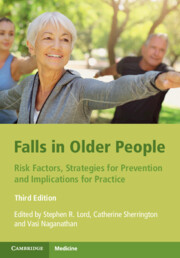Book contents
- Falls in Older People
- Falls in Older People
- Copyright page
- Contents
- Preface
- Contributors
- Part I Epidemiology and Risk Factors for Falls
- Part II Strategies for Prevention
- 16 Exercise to Prevent Falls
- 17 Volitional and Reactive Step Training
- 18 Cognitive-Motor Interventions and Their Effects on Fall Risk in Older People
- 19 Cognitive Behavioural Interventions for Addressing Fear of Falling and Fall Risk
- 20 The Medical Management of Older People at Risk of Falls
- 21 Fall Prevention Interventions for People with Visual Impairment
- 22 Footwear, Orthoses, Walking Aids, Wearable Technology, and Restraint Devices for Fall Prevention
- 23 Environmental Interventions to Prevent Falls at Home and in the Community
- 24 Fall Injury Prevention: Hip Protectors and Compliant Flooring
- 25 Multi-Factorial Fall Prevention Strategies: Where to Next?
- 26 Fall Prevention in Hospitals
- 27 Fall Prevention in Residential Aged Care Facilities
- Part III Implications for Practice
- Index
- References
21 - Fall Prevention Interventions for People with Visual Impairment
from Part II - Strategies for Prevention
Published online by Cambridge University Press: 04 November 2021
- Falls in Older People
- Falls in Older People
- Copyright page
- Contents
- Preface
- Contributors
- Part I Epidemiology and Risk Factors for Falls
- Part II Strategies for Prevention
- 16 Exercise to Prevent Falls
- 17 Volitional and Reactive Step Training
- 18 Cognitive-Motor Interventions and Their Effects on Fall Risk in Older People
- 19 Cognitive Behavioural Interventions for Addressing Fear of Falling and Fall Risk
- 20 The Medical Management of Older People at Risk of Falls
- 21 Fall Prevention Interventions for People with Visual Impairment
- 22 Footwear, Orthoses, Walking Aids, Wearable Technology, and Restraint Devices for Fall Prevention
- 23 Environmental Interventions to Prevent Falls at Home and in the Community
- 24 Fall Injury Prevention: Hip Protectors and Compliant Flooring
- 25 Multi-Factorial Fall Prevention Strategies: Where to Next?
- 26 Fall Prevention in Hospitals
- 27 Fall Prevention in Residential Aged Care Facilities
- Part III Implications for Practice
- Index
- References
Summary
As indicated in Chapter 4, there is good evidence that important visual functions including poor contrast sensitivity, deficient depth perception, and visual field loss increase the risk of falls and fall-related fractures in older people. Some visual impairments are amenable to intervention by surgery or refractive correction, and accordingly several randomized controlled trials have investigated visual interventions as a fall prevention strategy. This chapter provides summaries of these trial findings as well as a complementary study that evaluated the roles of exercise and home safety programmes for older people with visual impairment.
- Type
- Chapter
- Information
- Falls in Older PeopleRisk Factors, Strategies for Prevention and Implications for Practice, pp. 341 - 347Publisher: Cambridge University PressPrint publication year: 2021



